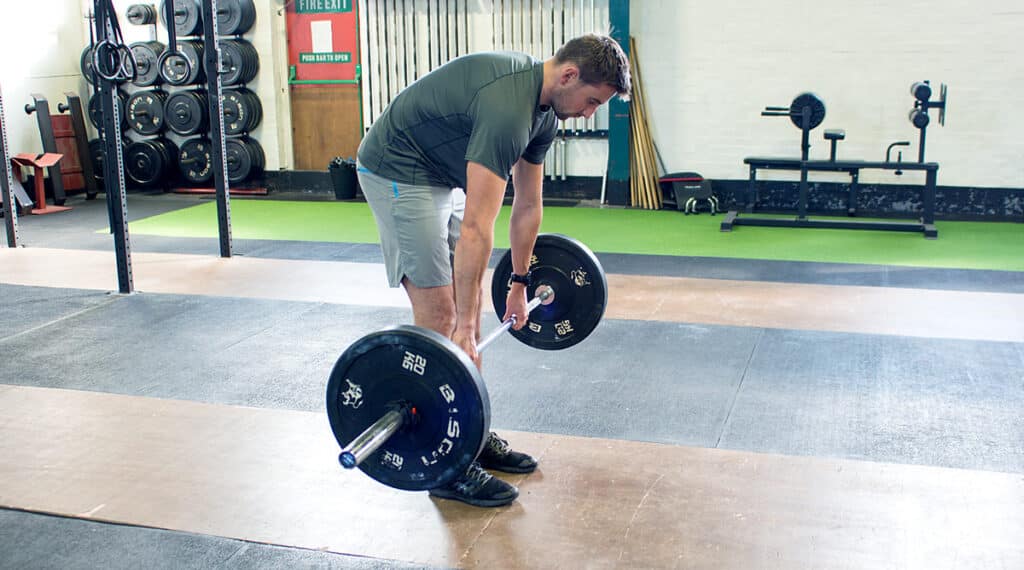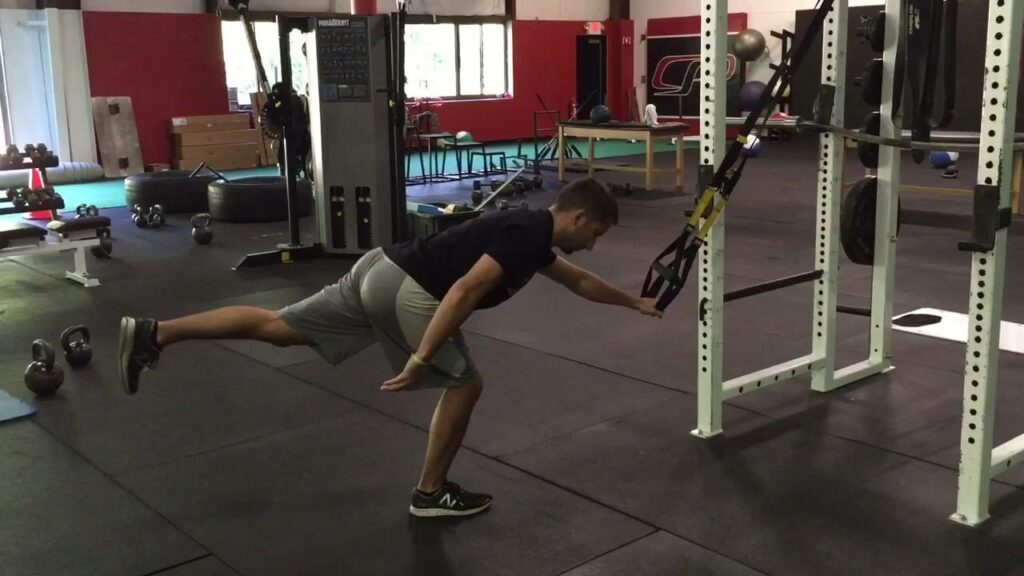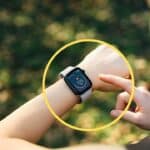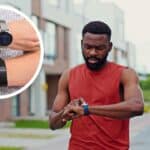The single-leg deadlift is one of the most potent, powerful, and complete exercises anyone can do. It’s critical for developing maximal strength and a healthy spine and core.
There are several variations of this movement that suit different populations and purposes.
In this article, we’ll cover all about the single-leg deadlift; the muscles that work, the benefits, the technique, and the variations that most suit your goals.
On top of that, we added a workout to put into practice what you learned!
Jump to:
Technique: Step-by-Step Guide
One of the most important aspects of any exercise is the technique. Learning how to execute a movement properly will minimize injury risk and enhance its benefits.
The single-leg deadlift work requires a combination of stability, coordination, mobility, and strength.
Keeping your body aligned while hinging the hips with a single leg can be challenging for many people, and that is why we compiled this step-by-step guide.
1) Stand on One Leg
Standing on one Leg is the essence of this deadlift variation. Keep the other Leg off the ground with a slight bend of the knee.
Some individuals may require a stick or the proximity of a wall to help stand still; no problem at all.
Think of grabbing the floor with your toes and contracting the glutes and core. This will help you gain balance.
The more comfortable you feel with this stance, the easier it will be to perform the movement with the proper technique.
2) Send Your Hips Back And Your Torso Forward
Standing on one Leg with a bent-knee hinge, simultaneously send your hips back and your torso forward while holding air in the diaphragm.
Doing this at the same time will engage your core and prevent you from losing stability. Don’t forget to keep grasping the floor with your toes.
Throughout this sequence, you want to maintain the weight of your body in the middle of your foot. Not the heels, the middle.
This will allow you to have more control of the body position at the end range of the movement.
3) Reach To Floor Parallel Maintaining a Neutral Neck
Keep sending the hips back until your torso is parallel to the floor. In this position, you want your neck to be neutral. Avoid looking up or at your thighs.
In other words, your neck should remain in the same place as the initial position during the full range of motion of the one-legged deadlift.
Your toes should still be grasping the floor.
4) Come up.
To come up, bring your hips forward while taking your torso upwards to the initial position.
At the end of the movement, you want your knees and hips locked, your neck neutral, and your core engaged.
Going down and up equals one complete rep.
Common Mistakes
Although single-leg exercises are suitable for many people, there are a few pointers to consider to improve the quality of the movement.
Maintaining a proper form should always be a priority for anyone attempting any movement.
Rounded Back

A rounded back is one of the most common mistakes in exercises involving a hip hinge.
There are many causes for this. In some cases, it’s due to a lack of proprioception. Meaning the person is not conscious of where their body is concerning space.
In other scenarios, people have weak posterior chain muscles. Because of this, they cannot keep their shoulder blades retracted and maintain a neutral spine.
To correct this, it’s essential to enforce a proper form from the starting position and with light weights or body weights. Extra work like superman, back extension, and good mornings are great ways to correct the rounded back.
Looking Up
When doing hinge-dominant exercises like unilateral deadlifts, it’s crucial to maintain a neutral neck.
Looking up while your body is going down can cause unnecessary tension in your neck and affect your balance and technique.
It can also prevent you from correctly engaging your core muscles since a mind-movement disconnection will occur.
To correct this, think, “where the torso goes, the look goes.” This cue will help you minimize the strain in your neck and help you engage the core more.
You will feel like the movement flows more effortlessly from top to bottom.
Non-Ideal Shoes
One of the most common problems of anyone attempting single-leg deadlifts is a lack of balance. The shoes play a crucial role in this.
Today’s athletic shoes have irregular soles, with high heels that allegedly help with grip.
Although it may be true, it doesn’t help with static exercises like a single-leg deadlifts, squats, or regular deadlifts.
Low-heel or flat-heel shoes help maximize the area your foot can cover.
These shoes often called “minimalist shoes,” should be a great addition to the balance component that your training may be lacking.
Benefits & Muscles Worked
Training the body with unilateral exercises has tremendous benefits for the body and mind.
Not only it enhances focus and attention, but it also improves balance along with strength and hypertrophy.
The best part is that anybody can do them. Even if you start with unilateral body exercises, you can add weight as you progress.
Muscles Worked
The unilateral deadlift is a hip-dominant exercise. This means that every muscle engaged in hip extension and core stability will be a target.
Hamstrings
Hamstring muscles are one of the most recruited groups during this movement. The hamstrings are responsible for hip extension and knee flexion.
A single-leg deadlift will work these muscles in the lengthened position when the hip reaches maximal flexion while preserving tension.
Butt muscles
The glutes or buttock muscles are also in charge of hip extension and pelvis stability. They activate the most while extending the hips and at the end range of hip flexion.
Most of the engagement, like the hamstrings, is in the lengthened position. This is perfect for sports that require aggressive hip extension and pelvis stability.
Some examples are running and Olympic weightlifting.
Core
The SLD is an excellent core training exercise as well.
Core strength will keep the spine neutral during movement allowing it to endure external loads safely.
These muscles include the lower back, spinal erectors, rectus abdominis, internal and external obliques, and transverse abdominis.

Foot muscles
Another important group is the foot muscles. The SLD places a high load on these muscles since they are the first ones called to maintain stability.
Weak feet will open opportunities for knee and hip compensations that will create unnecessary tension, thus increasing the risk of injury.
The entire foot will be targeted throughout the movement to maintain balance.
Improve Balance And Stability
Our bodies operate more functionally bilaterally. Jumping with two legs is easier than one Leg, pressing with two arms requires more effort than one arm, and so on.
The reason is that it takes less energy to move our body bilaterally than unilaterally. However, this doesn’t mean we shouldn’t train one extremity at a time.
The SLD will force you to put all your attention and focus on the feet on the ground. This action will prompt your Central Nervous System (CNS) to double down on balance and stability.
It’s not to say that the results will be immediate, but you will notice improvement pretty quickly.
If you find it too difficult, try using a stick or other support to help you get familiar with the sensation of holding your weight on one Leg.
Increases Unilateral Strength And Hypertrophy
When performing bilateral leg exercises, it’s hard to tell if both extremities are putting in the same effort.
If left unchecked, this could result in strength and hypertrophy disparity. The SLD can aid in increasing these variables evenly.
Placing all your body weight on one leg will expose your muscles to high muscular tension, pushing them to adapt and grow.
When training for sports, training unilaterally has significant advantages since many power positions begin with one foot in front of the other (basketball shots, baseball swings, running sprints, etc.)
Rectify Asymmetries
The majority of movements and exercises are done bilaterally. When you learn, any lower or upper body movement is usually with two legs or two arms.
Although this improves bilateral strength and is relatively easier, it can create and maintain asymmetries.
Such asymmetries are not necessarily physical; they can also be neurological. Some people may find unilateral movement with one extremity better than the other.
The one-leg deadlift can create a healthier and more functional movement pattern. And it does so from the ground up (foot, knee, hip, torso, neck.)
As the progressive overload continues, you will notice slight improvements both aesthetically (if there were asymmetries) and neurological (mind-muscle connection.)
Different Variations
There are multiple single-leg deadlift variations, each serving a different purpose or population. Some of these versions are better for beginners or injured individuals.
However, anyone can include them in their training program as an accessory for hypertrophy and strength or as a balance-improving exercise.
SLDs can be performed with added weight (barbells, kettlebells, dumbbells) or in the bodyweight version.
Assisted One-Leg Deadlift
The assisted one-leg deadlift is a perfect variation for people looking to get the benefits of the single-leg movement while getting help with balance.
Such assistance can be through a PVC pipe, stick, bench, or wall. The idea is to have something near you to prevent falling and losing your position.

This is also perfect for practicing the proper movement before adding more weight.
Banded Single Leg Deadlift
The banded single-leg deadlift is an excellent variation to maintain muscle tension through the entire range of motion.
For this movement, pick a resistance band and place it under the active leg (the one on the floor), hold both ends with each hand, and proceed to stand up.
This will make the exercise harder as you go up because the band will gain more resistance. After a few reps, you will feel your glutes and lower back firing up due to the intense muscle activation.
Many use this variation at the end of their workouts to add more volume and end their training sessions with a pump.
Single-Leg Glute Bridge
The single-leg glute bridge is a fantastic way to unilaterally target the glutes and hamstrings while being gentle on the lower back.
For this variation, you’ll adopt a supine position on the floor with your hands at your sides. The active Leg should be flexed around 90 degrees, and the other Leg off the ground.
From this position, drive your active foot to the ground while sending your hips up to the ceiling and contract your glutes at the top.
This is a terrific modification for people with severe lack of balance, back pain, or the elderly.
Single-Leg Romanian Deadlift
The single-leg Romanian deadlift differs from the traditional version because it has less knee bend, thus targeting the glutes and hamstrings more.
This variation is more suitable for advanced athletes who have mastered deadlift basics.
When done right, it can enhance muscle growth and be used as a corrective exercise in any conditioning program.
Weighted Single-Leg Deadlift
The weighted variation is an advanced exercise usually done by the most experienced lifters and fitness enthusiasts.
It’s a way of taking advantage of heavy weights to build more strength and hypertrophy.
Although anyone can progress to perform this movement, it should be done carefully due to the high muscular tension on every rep.
Try This Workout!
It is time to practice everything you’ve learned with this workout. Before starting, be mindful of your fitness level and modify the intensity accordingly.
This workout is for everybody who’s up to the challenge but don’t forget to put technique before anything else!
We’ll focus on your hamstrings, glutes, and core. You can do it bodyweight or with added weight.
Have fun!
Warm Up: 2 Rounds
– 20 Jumping Jacks
– 5/5 Hip Airplanes
– 10 Hollow Rocks
Part A: 3 Rounds, 60-120s rest
– 12/12 Single Leg Romanian Deadlift
– 10/10 Bulgarian Split Squat
– 20s Side Plank (each side)
Part B: 3 Rounds, 60-120s rest
– 15/15 Single Leg Glute Bridge
– 12/12 Banded Single Leg Deadlift
– 20 Bicycle Crunches
Feel free to add extra weight or to perform with your body weight.
FAQs
- What Are Single-Leg Deadlifts Good For?
Single-leg deadlifts improve balance and stability and increase strength and hypertrophy while rectifying asymmetries.
- Do Single-Leg Deadlifts Grow Glutes?
Yes, they do. Deadlifts are great at developing the lower part of your glutes, giving them a “lift.”
- Why Are Single-Leg Deadlifts So Hard?
They tend to be hard for people that lack balance and stability. If you’re one of these people, try performing the movement with the help of a stick.















